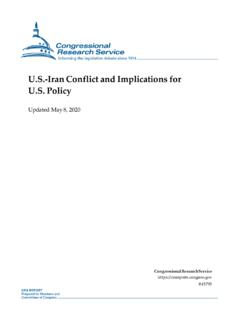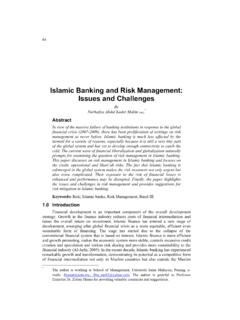Transcription of CHAPTER 1 THE MEANINGS OF PEACE - SAGE Publications Inc
1 3We need an essentially new way of thinking if mankind is to survive. Men must radically change their attitudes toward each other and their views of the future. Force must no longer be an instrument of politics.. Today, we do not have much time left; it is up to our generation to succeed in thinking differently. If we fail, the days of civilized humanity are numbered. Albert EinsteinThis text is based on a number of assumptions. War is one of humanity s most pressing problems; PEACE is almost always preferable to war and, moreover, can and must include not only the absence of war but also the establishment of positive, life-enhancing values THE MEANINGS OF PEACECHAPTER 1A man releasing a dove, which is widely considered a symbol of world : Nathan Lau/Design PART I: THE PROMISE OF PEACE , THE PROBLEMS OF WARand social structures.
2 We also assume, with regret, that there are no simple solutions to the problems of war. Most aspects of the war- PEACE dilemma are complex, interconnected, and, even when well understood, difficult to move from theory to practice. On the other hand, much can be gained by exploring the various dimensions of war and PEACE , including the possibility of achieving a more just and sustainable world a way of living that can nurture life itself and of which all people can be this book, we maintain that there is good reason for such hope, not simply as an article of faith but based on the realistic premise that human beings are capable of understanding the global situation and of recognizing their own species-wide best interests.
3 Humans can behave rationally, creatively, and with compassion. Positive steps can be taken that will diminish our species reliance on violence in attempting to settle disputes and that will facilitate the develop-ment of a more just, sustainable, and truly peaceful people think they know what PEACE means, but in fact different people often have very different understandings of this seemingly simple word. And although most would agree that some form of PEACE whatever it means is desirable, there are often vigorous, even violent, disagreements over how to obtain MEANINGS of PeacePeace, like many theoretical terms, is difficult to define. Like happiness, harmony, justice, and freedom, PEACE is something we often recognize by its absence.
4 Consequently, Johan Galtung, a founder of PEACE studies and PEACE research, has proposed the important distinction between positive and negative PEACE . Positive PEACE denotes the simultaneous presence of many desirable states of mind and society, such as harmony, justice, equity, and so on. Negative PEACE has historically denoted the absence of war and other forms of large-scale violent human philosophical, religious, and cultural traditions have referred to PEACE in its positive sense. In Chinese, for example, the word heping denotes world PEACE , or PEACE among nations, while the words an and mingsi denote an inner PEACE , a tranquil and harmonious state of mind and being, akin to a meditative mental state.
5 Other languages also frame PEACE in its inner and outer English lexicon is quite rich in its supply of terms that refer to PEACE . In Webster s Third New International Dictionary, for example, PEACE is initially defined as freedom from civil clamor and confusion and positively as a state of public quiet. 1 This denotes negative and positive PEACE in their political or outer sense. Webster s proceeds further to define (political or outer) PEACE positively as a state of security or order within a community provided for by law, custom, or public opinion. The second definition of PEACE , according to Webster s, is a mental or spiritual condition marked by freedom from disquieting or oppressive thoughts or emotions.
6 This is PEACE in its personal or inner sense, PEACE of mind, as well as calmness of mind and heart: serenity of spirit (inner PEACE ). Third, PEACE is defined as a tranquil state of freedom from outside distur-bances and harassment. PEACE also implies harmony in human or personal relations: mutual concord and esteem. This is what we might call interpersonal or intersubjective is then defined by Webster s as a state of mutual concord between governments: absence of hostilities or war. This is the conventional meaning of PEACE , as negative PEACE , caused by the period of such freedom from war. The sixth definition of PEACE is the absence of activity CHAPTER 1: The MEANINGS of PEACE 5and noise: deep stillness: quietness, or what may be called positive inner PEACE .
7 And in its seventh and final lexicographical meaning, PEACE is personified as one that makes, gives, or maintains tranquility. This is what might be called divine or perpetual PEACE , with God as the ultimate cause of PEACE on Earth. In some cases, the word PEACE even has an undesirable connotation. The Roman poet Tacitus spoke of making a desert and calling it PEACE , an unwanted place of sterility and emptiness. Similarly, although nearly everyone seeks PEACE of mind or inner PEACE , the undesired PEACE of a coma or even of death may not seem so desirable. To be pacified (derived from the Latin word for PEACE , pax) often means to be lulled into a false and misleading quietude. Indeed, appeasement buying off a would-be aggressor has a very bad name indeed.
8 In the most noto-rious example, British prime minister Neville Chamberlain appeased Hitler in September 1938, famously declaring as he signed the Munich Agreement, which essentially gave in to all of Hitler s demands: I believe it is PEACE for our time. (Less than a year later, Hitler invaded Poland, effectively starting World War II on the European continent.) By contrast, even the most PEACE -loving among us recognize the merits of certain martial and aggressive attitudes, acts, and metaphors, especially when they refer to something other than direct military engagements: President Lyndon Johnson s war on poverty, for example, or the medical war on cancer and battle against AIDS. Some Eastern Concepts of PeaceThe foregoing is not simply a matter of playing with words.
9 Fighting, striving, and engaging in various forms of conflict and combat (especially when they are successful) are widely associ-ated with vigor, energy, courage, and other positive virtues. Nonetheless, it is no exaggeration to claim that PEACE may be (with happiness) the most longed-for human philosopher Lao Tzu (6th century BCE), founder of Taoism and author of the Ta o Te Ching, emphasized that military force is not the Ta o, or Way, for human beings to follow. He frequently referred to peaceful images of water or wind both of them soft and yielding yet ultimately triumphant over such hard substances as rock or iron. The teachings of K ung fu-tzu (or Confucius, approximately 551 479 BCE) are often thought by most Westerners to revolve exclusively around respect for tradition, including elders and ancestors.
10 But Confucius did not hold to these ideas because he valued obedience and order as virtues in themselves; rather, he maintained that the attainment of PEACE was the ultimate human goal and that PEACE came from social harmony and equilibrium. His best-known collection of writings, the Analects, also emphasizes the doctrine of jen (empathy), founded on a kind of hierarchical Golden Rule: Treat your subordinates as you would like to be treated by your writings of another renowned ancient Chinese philosopher and religious leader, Mo Tzu (468 391 BCE), took a more radical perspective. He argued against war and in favor of all-embrac-ing love as a universal human virtue and the highest earthly goal, yet one that is within the grasp of each of us.

















